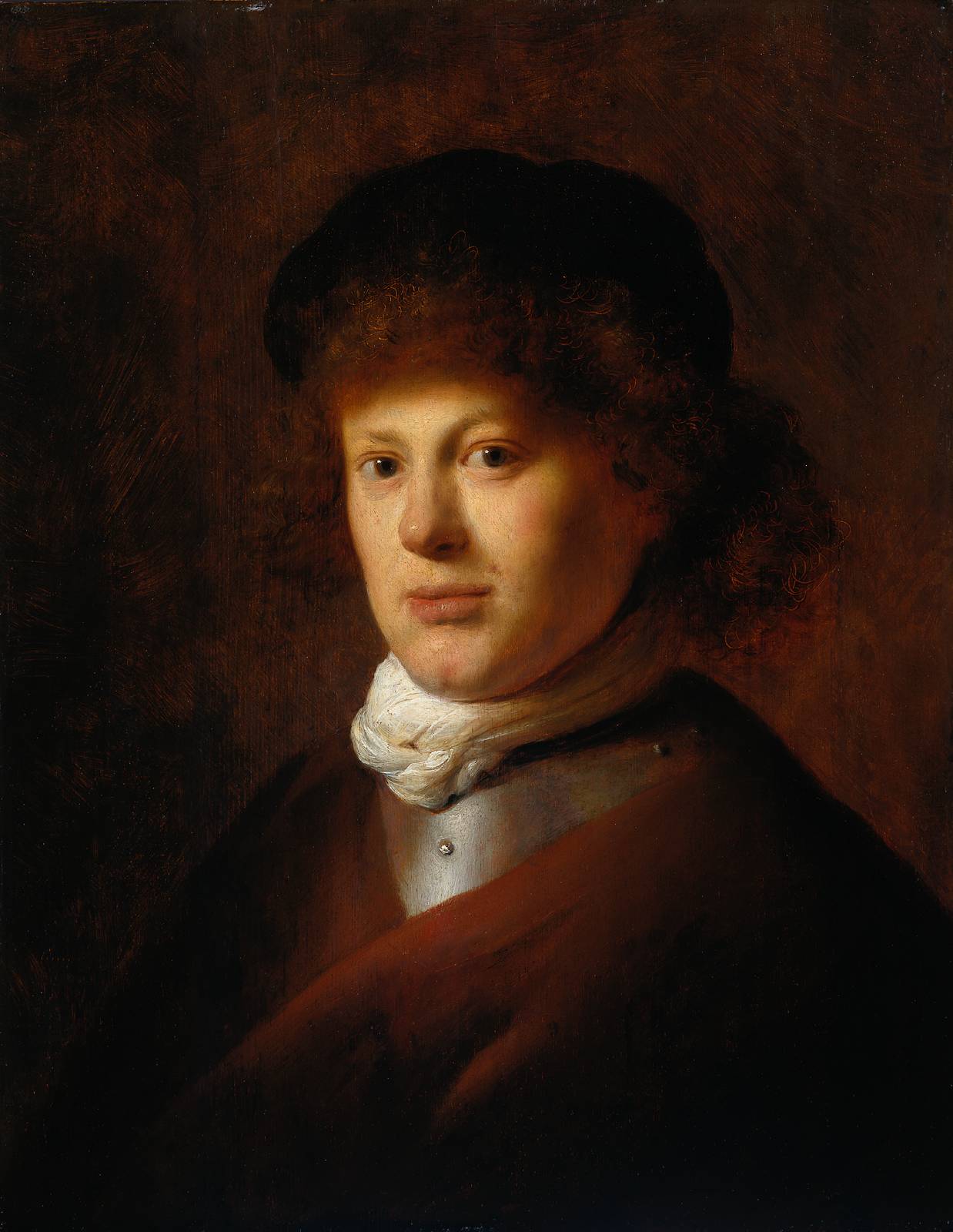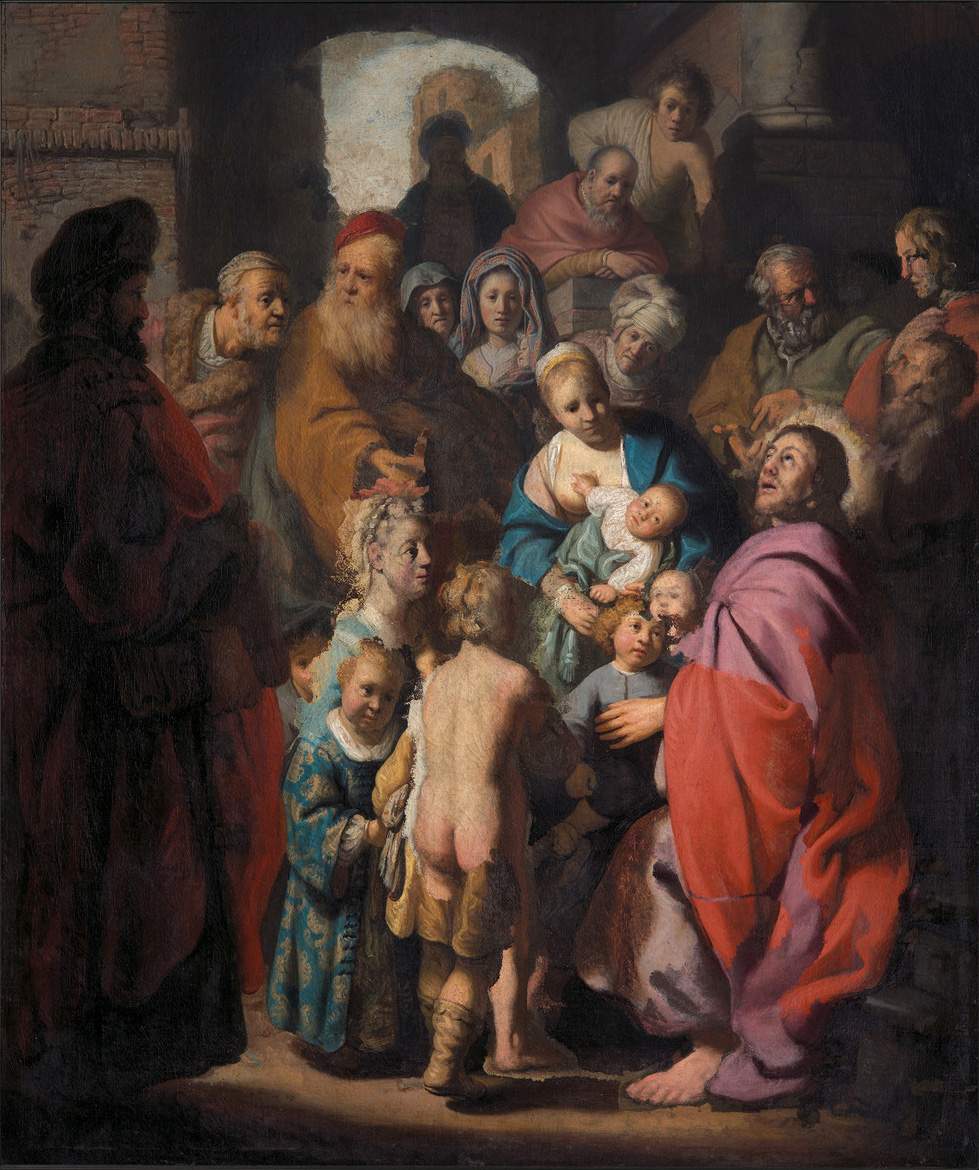Walking through the streets of Leiden(Leiden in Dutch) one can still feel the atmosphere of RembrandtHarmenszoon van Rijn (Leiden, 1606 - Amsterdam, 1669), the famous Dutch painter to whom the city gave birth in 1606. A plaque on the building where he was born commemorates this event that took place on July 15 of that year, and from here it is natural to go in search of the places associated with him, such as the church where he was baptized, the Latin School that the artist attended and the studio where he began working as an apprentice, now called the Rembrandt Studio. However, unlike JanVermeer (Delft, 1632 - 1675) who was born and remained in Delft all his life, Rembrandt spent only his childhood and youth in Leiden, until 1631, when he moved to Amsterdam.
The son of a miller and a baker’s daughter, Rembrandt received a high level of education thanks to his family’s good finances: He began attending the Latin School, the city’s elite school, and enrolled at theUniversity of Leiden, considered the oldest in the Netherlands, but here he only studied for a short time, as he felt that his great passion, that for painting, would become his profession; he was therefore already convinced that his path would be that of art. He therefore began to work in the workshop of a local painter, Jacob van Swanenburg (Leiden, 1571 - 1638), who devoted himself mainly to history painting, and together with his master he stayed for three years; he then completed a short but intense six-month apprenticeship in Amsterdam with the painter Pieter Lastman (Amsterdam, 1583 - 1633). He then returned to his hometown and decided to open his own studio in 1624-1625, which he shared with another artist, his friend Jan Lievens (Leiden, 1607 - Amsterdam, 1674), and about two or three years later began to take on pupils of his own. Gerrit Dou (Leiden, 1613 - 1675) was one of these. His good fortune, however, providentially happened to him in 1629, when he was discovered by Constantijn Huygens, a well-known statesman whose knowledge provided the artist with commissioning relationships with the court, so much so that until the mid-1640s he continued to make paintings for Prince Frederick Henry of Orange. A relationship with the Dutch court that thus lasted even when Rembrandt left Leiden for Amsterdam.
The works he produced in Leiden are therefore those of his youth, of his beginnings, in which he nevertheless laid the foundations, yes, for his future artistic activity, but his great painterly gifts and his propensity toward continuous experimentation and innovation are already very clear. In fact, Rembrandt was an artist who was never content to reach a particular milestone either in technique or in the representation of the most diverse themes: his life was characterized by a constant desire to do more and more, to go beyond what he had already experimented with in order to face new tests and perspectives.
In the major exhibition that Leiden has dedicated to him until February 9, 2020, in the rooms of Museum De Lakenhal, entitled Young Rembrandt. Rising Star, on the occasion of the 350th anniversary of Rembrandt’s death , the intention of the curators was to tell the story of the artist’s youthful activity, which was already full of the prerequisites to give birth to his extraordinary career that would forever inscribe him in the aura of the greatest painters ofDutch art and its Golden Age.
On the occasion of the exhibition paintings, drawings and engravings belonging to those early years of his activity have returned to Leiden, thanks to the curatorship resulting from a relevant international collaboration between Museum De Lakenhal and the Ashmolean Museum in Oxford, but the paintings come from museum venues around the world, including the National Gallery Ireland in Dublin, the Gemäldegalerie in Berlin, the Musée Jacquemart-André in Paris, the Metropolitan Museum in New York, the National Gallery in London, the J.Paul Getty Museum in Los Angeles, and from private collections. Alongside Rembrandt’s works, paintings by Van Swanenburg, Lastman, and Lievens were also displayed for greater contextualization of that period.
In a vividly hued display that sets the stage for important masterpieces, one can perceive the wide variety of subjects that Rembrandt had already depicted in his younger years, from self-portraits to portraits, from allegorical themes to biblical and mythological subjects.
The artist’s earliest known work is in the Museum De Lakenhal and is allegorically themed: it is the Spectacle Seller, better known as the Allegory of Sight and part of a series in which Rembrandt depicted the five senses. The woman on the right, a traveling saleswoman, hands a pair of spectacles to the elderly man who gestures that he needs them; at the man’s side is a lady holding her eyes very tightly shut, almost closed, as a sign of blindness. It has been speculated that the elderly couple, with somewhat caricatured features, is actually the artist’s father and mother. The work dates from around 1624, when Rembrandt, having returned from his brief apprenticeship in Amsterdam, decided to open his studio.
Two years later, from 1626, however, is another painting kept in the Leiden Museum, on loan from the Cultural Heritage Agency of the Netherlands: Historical Painting, the subject of which has not yet been clearly defined, but it is significant because within it the artist depicted himself, that is, the man behind the ruler’s scepter. Thus began the vast production of self-portraits: throughout his artistic activity there are about one hundred of them, including paintings and drawings; he is probably the painter who more than any other depicted himself.
Juxtaposed in the exhibition are the small Self-Portrait of 1628 from the Rijksmuseum in Amsterdam with the Portrait of Rembrandt made in about 1629 by Jan Lievens: in the former we see the play of light and shadow, as the face is shrouded in shadow and the light illuminates his cheek, while in the latter the brown tones are played with, but it is brighter.
Between 1628 and 1631 Rembrandt made dozens and dozens of etchings depicting him in a wide variety of expressions, experimenting with different effects and techniques.
 |
| Rembrandt, Selling Glasses (ca. 1624; oil on panel, 21 x 18 cm; Leiden, Museum de Lakenhal) |
 |
| Rembrandt, Historical Painting (c. 1626; oil on panel, 90 x 122 cm; Leiden, Museum de Lakenhal) |
 |
| Jan Lievens, Portrait of Rembrandt van Rijn (1629; oil on panel, 57 x 44.7 cm; Amsterdam, Rijksmuseum) |
In addition to self-portraits, Rembrandt devoted himself to portraits of men and women: among the works on display are the Noble Oriental of 1632, from the Metropolitan Museum in New York, and two close-ups of women that have been placed side by side, namely the Portrait of an Eighty-Three-Year-Old Woman and the Portrait of a Woman executed in 1633. The former, kept at the National Gallery in London, dates from 1634: the elderly lady depicted, who catches the viewer’s eye by how penetrating she is, has been identified as Aertgen Claesdr, mother of Rotterdam brewer Dirck Jansz Pesser, and perhaps the picture was actually painted during a “hit-and-run” business trip to the city in July 1634. The woman is dressed in black with a white ruff around her neck, contrasting with the dark color of her dress, and a characteristic Dutch headdress that is also white. The work is thus built on a strong contrast of light and dark, and it seems as if the figure emerges from the oval in a kind of three-dimensional effect. The facial features are pronounced, especially the nose and chin; one can sense the desire to depict a woman in old age from the facial skin and the gray hair that can be glimpsed peeking out from under the headdress. In contrast, the Portrait in the private collection depicts a younger woman: her skin is smooth and flushed on her cheeks and her hair is brown; she is looking directly at the viewer, unlike the previous painting in which the elderly woman’s gaze was averted downward. From the way she is dressed, it is clear that she is a member of the Amsterdam elite: she wears a very wide ruff with a thin gold chain and on her head a finely embroidered headdress. Originally the painting had its pendant, in which her husband was depicted. These are two ordinary portraits for his work as a painter of the time, but they fascinate anyone who looks at them because of their careful refinement and, in both cases, because of the contrast the artist intended to create between the black dress and the white ruff and headdress.
As already stated, Rembrandt dealt with the most diverse themes: allegorical paintings such as theAllegory of Sight, historical paintings such as the Historical Painting in Museum De Lakenhal, to which are added biblical paintings such as Let the Children Come to Me, made in about 1627 (and recently attributed to Rembrandt), dedicated to the Gospel passage in which Jesus blesses a group of children and teaches them his word, and also included in this work is a self-portrait of the artist, namely the young man depicted at the top of the group, above the figures dressed in oriental garb. Or Christ at Emmaus of about 1628 kept at the Musée Jacquemart-André in Paris.
 |
| Rembrandt, Noble Oriental (1632; oil on canvas, 152.5 x 124 cm; New York, Metropolitan Museum of Art) |
 |
| Rembrandt, Portrait of an Eighty-Three-year-old Woman (1634; oil on panel, 71.1 x 55.9 cm; London, National Gallery) |
 |
| Rembrandt (attributed), Sinite parvulos venire ad me (c. 1627-1628; oil on canvas; Private collection) |
 |
| Rembrandt, Christ at Emmaus (1629; oil on paper, 39 x 42 cm; Paris, Musée Jacquemart-André) |
 |
| Rembrandt, Rape of Europa (1632; oil on panel, 62 x 77 cm; Los Angeles, J. Paul Getty Museum) |
And finally paintings with a mythological character, such as the Rape of Europa from the J. Paul Getty Museum in Los Angeles and completed in 1632. The artist had already worked on the depiction of abductions of female figures, particularly the Rape of Proserpine (a 1630 specimen on view in the exhibition is housed at Gemäldegalerie in Berlin), but in putting the Rape of Europa on canvas he achieves one of his finest paintings. In the water Europa, dressed in sumptuous clothes, has already been abducted by Zeus in the guise of a bull and turns back in fear toward the people left on the shore: two young women closer to the water, also dressed in luxurious clothes with brocades and golden outlines, one of whom raises her arms to the sky as if to scream visibly in despair, dropping the garland of flowers she was intent on weaving, and the couple left near the horse-drawn carriage: the coachman immediately stands up and watches in terror as the abduction takes place without being able to do anything to save the maiden. A sudden scene in which one can sense the excitement and desperation of those present and the terror of abducted Europa. In the background the artist depicts the outline of a city shrouded in fog, giving the illusion of an ancient Tyre (Europa was its princess) but also of a 17th-century Amsterdam.
An excursus of works to tell how out of the ordinary Rembrandt’s youthful activity, which took place almost entirely in his hometown, was.
Warning: the translation into English of the original Italian article was created using automatic tools. We undertake to review all articles, but we do not guarantee the total absence of inaccuracies in the translation due to the program. You can find the original by clicking on the ITA button. If you find any mistake,please contact us.